The name Ahrefs can often be found on SEO forums and specialized conferences — and not just because it looks like a popular HTML tag. This is one of the top services for complex website optimization, which is among the leaders in terms of the range of features and the depth of data analysis.
In fact, we had mixed feelings after the Ahrefs review. On the one hand, the platform really provides an incredible amount of information that turns into real gold in the hands of an experienced analyst. On the other hand, most new users may simply fail to cope with this task due to the complexity of the interface, lack of tips, and confusing report structure.
Another aspect of the Ahrefs review 2024, which is worth mentioning, is the inflexible access conditions. The developer offers only a few subscription plans without the possibility of customization. Moreover, by default, they are designed for only one user, and the connection of a team will cost much.
So, who will be the main target audience of the service? Is it worth connecting to it in 2024? We will try to answer these questions in today’s Ahrefs review.
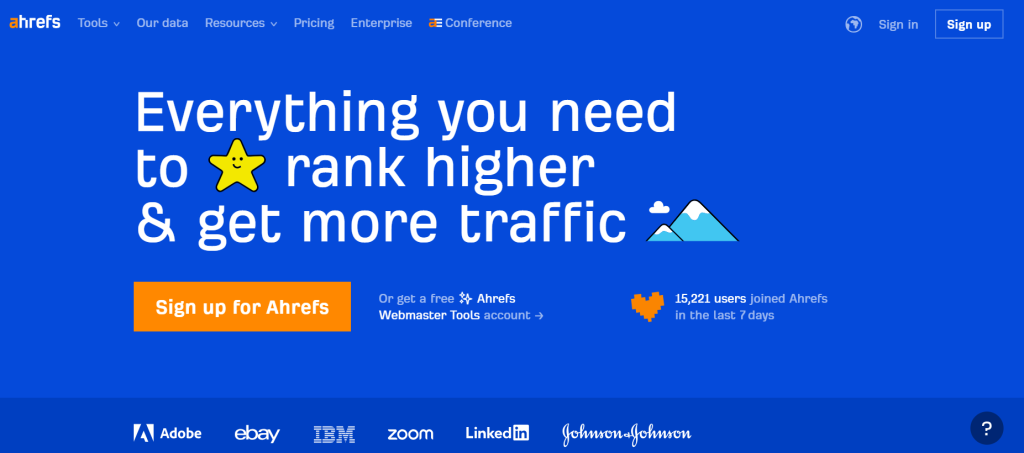
Pros
- Powerful web page crawling system
- Great keyword research
- Detailed domain and SERP analysis
- Keyword management capabilities
- Top-notch web link index
- Advanced filtering tools for power users
Cons
- Single-user subscription plan (5 additional users cost $1K)
- Lacks SEO reporting features
- Basic UX functionality
- No mobile app
Overview
Ahrefs was released into the world back in 2011 and became one of the top SEO software solutions in no time. It is the go-to tool for growing online presence for a lot of SEO gurus, content writers and web developers.
According to Ahrefs, their backlink index has around 300 billion indexed pages and over 17 trillion backlinks, which is the largest among all other popular SEO tools. When you combine this with a great keyword explorer and competitor monitoring features, Ahrefs can give you everything you need to climb rankings, but for a price.
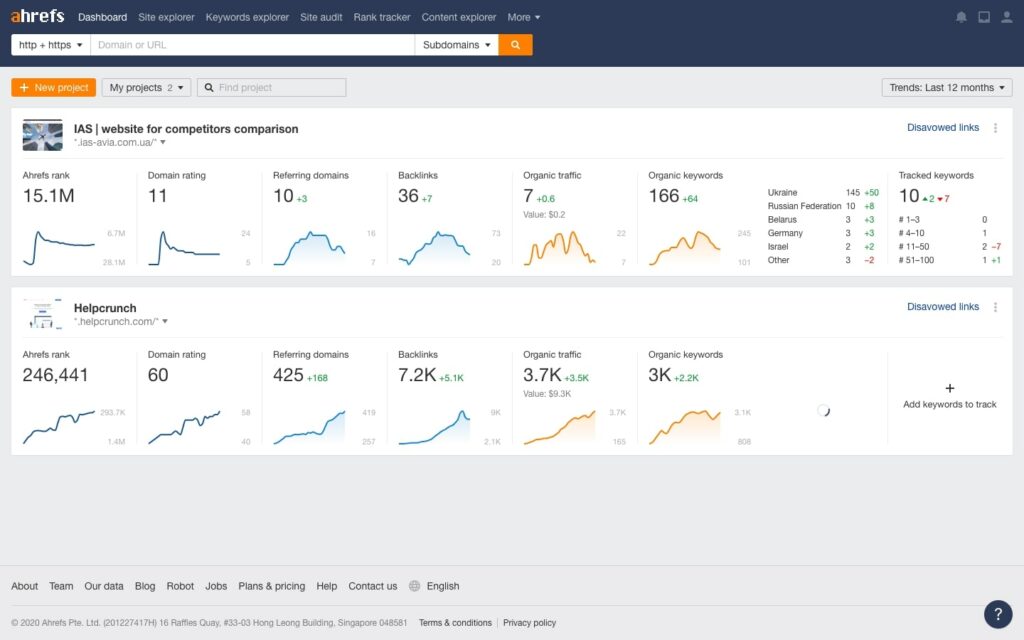
Despite the fact that Ahrefs does feature a range of SEO tools, its user interface, unfortunately, isn’t too intuitive. It’s almost as if the tool was specifically designed for professionals who know their way around SEO just like the back of their hands.
With annually billed pricing plans starting at $82 per month, Ahrefs offers domain comparisons, keyword research and tracking, and other essential SEO tools in addition to its backlink checking capabilities. All in all, it’s a solid all-round tool that can help you produce quality SEO results. It is all the more interesting to read Ahrefs reviews and understand what exactly comes to the fore — rich functionality or an inconvenient interface.
Pricing & Plans
Ahrefs offers four subscription plans with preset account limits. This isn’t exactly the most pocket-friendly solution out there, but it also isn’t the most expensive one. Ahrefs is right down there in the middle.
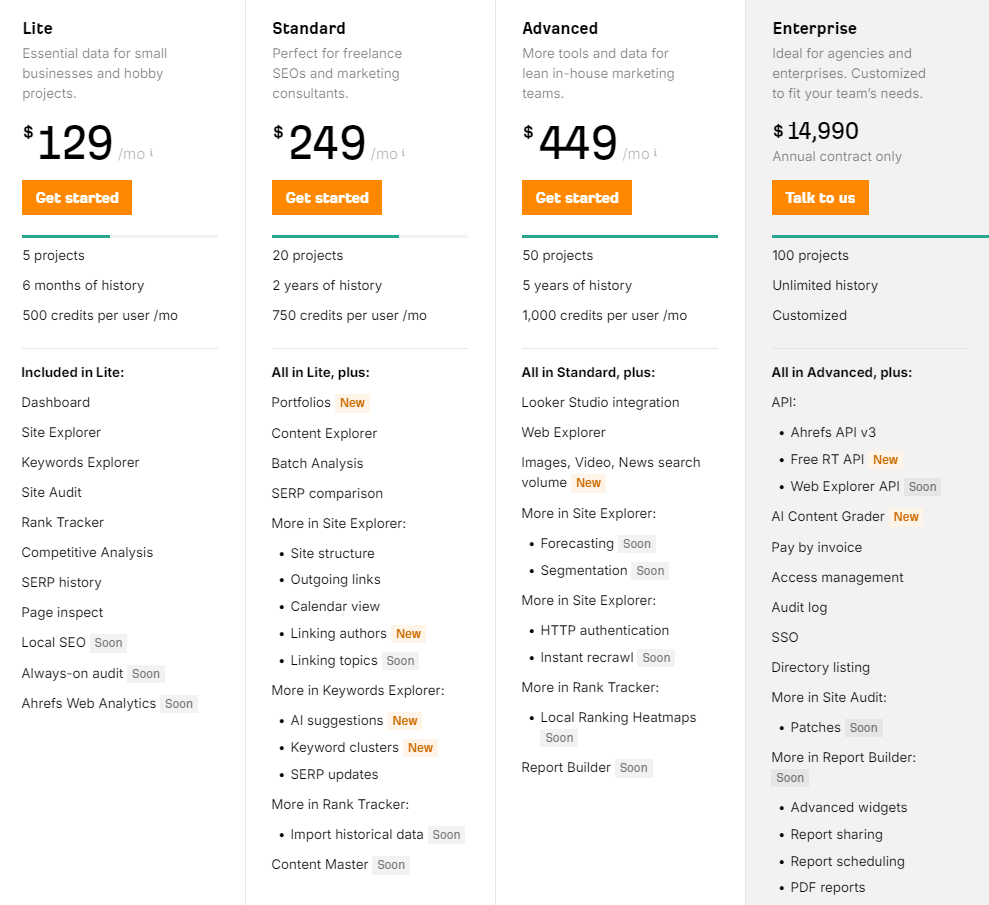
If you go for monthly billing, the cheapest plan in Ahrefs–Lite–will cost you $129. With this subscription plan, you get one user, you can track upto 5 websites, keep track of 750 keyword rankings each week. You will have 500 credits to use the Site Explorer. On top of that, there are limits on how many results can be exported from ranking and backlink indexes.
The next subscription plan–Standard–costs a monthly price of $249 and is a solid solution for small to midsize businesses. In Ahrefs reviews, the service is often called the most popular because it is consistent. For this price, you can track up to 20 websites, and keep track of 2,000 keyword rankings every three days. You will have 750 credits to use the Site Explorer.
The Advanced plan offers the third subscription plan level. At $449 a month, you get Ahrefs premium features, and can track 50 websites for one user. You will have 750 credits to use the Site Explorer
Last up, Ahrefs has the Enterprise plan that is priced at a whopping $14,990 a month. The Enterprise plan allows you to track web mentions in real-time, provides reports on backlinks every hour, as well as much higher account limits on tools like Keyword, Site, and Content Explorer. Most companies will get enough from the Standard and Advanced plans.
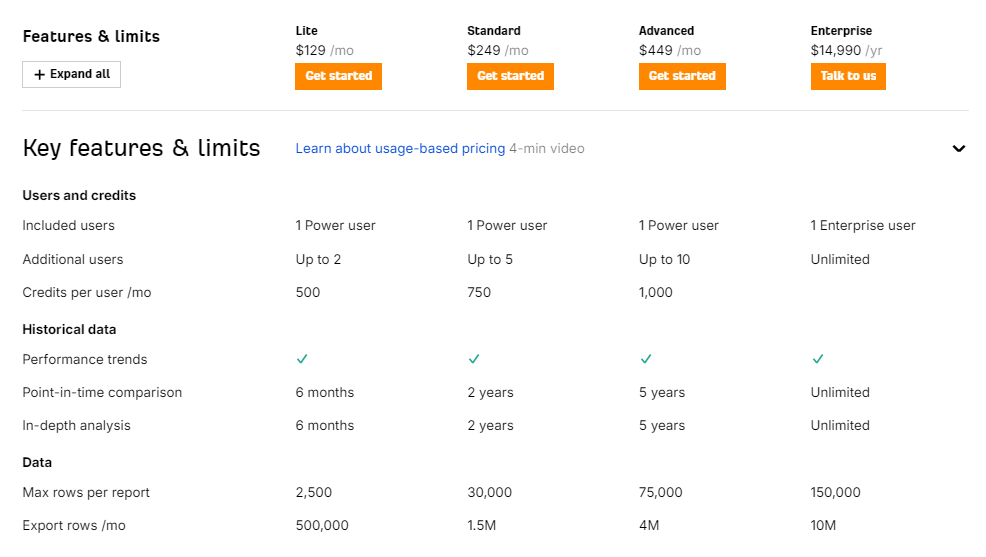
Rank Tracker
Ahrefs keyword position tracking capabilities are expressed by the Rank Tracker tool. And just like the name suggests, it helps you keep track of rankings of your tracked keywords.

Besides performing its main function, the tool also monitors SERP features for your keywords, shows how much traffic you should expect to get from each tracked keyword, lets you see ranking dynamics, and do so much more both for desktop and mobile. While conducting our research to review Ahrefs, we came to the conclusion that the service simply has no competitors in this regard.
Let’s take a look at everything you see in the Rank Tracker dashboard after adding a website. First, you get the Visibility score, which is the percentage of clicks that fall on your website in all of the SERPs that feature your target keywords. Second, the Average position lets you know what the average ranking position is for all of the keywords you track. So, basically, it gives you a general feel of your keyword campaign. Next, we have Traffic which is the volume of estimated organic traffic you’ll drive to your site each month using your tracked keywords.
The SERP features report lets you know how many featured snippets show up for your tracked keywords, and how many SERP features your website is featured on. The more SERP features you show up for, the fewer results there will be on the first page of Google. Last, the Position metric displays how your keyword ranking positions have changed. With this data, you can get a grasp of how your keyword campaigns are coming along.
Besides providing you with the aforementioned metrics for analysis, there are several ways to benefit from various Rank Tracker reports.
The Overview report gives you a general breakdown of your keyword ranking positions. It is simple, as we will demonstrate in the review of Ahrefs.
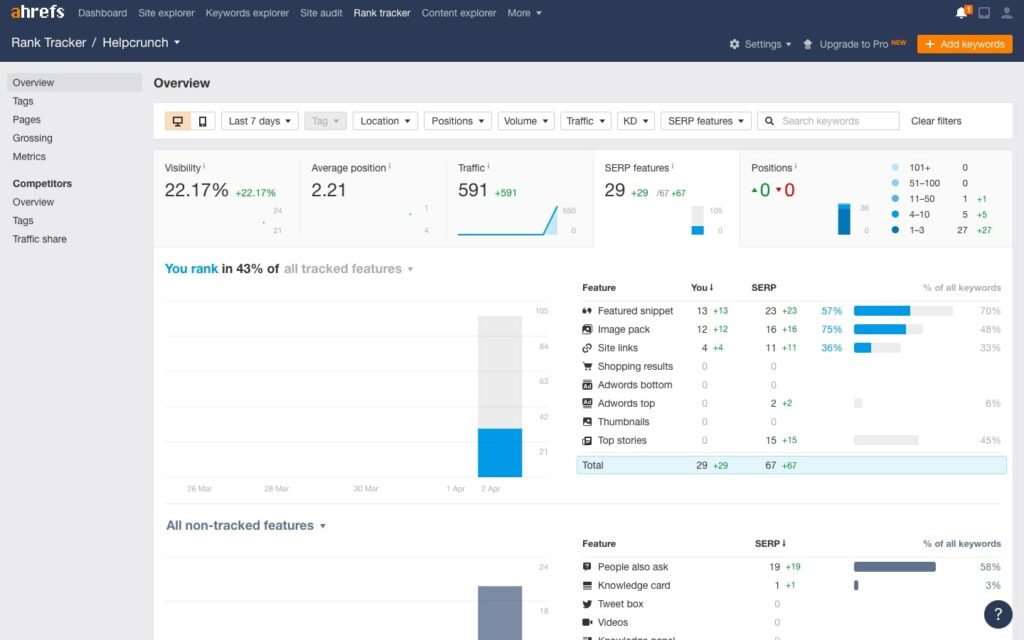
Here you can click on the different tabs at the top of the report like Visibility, Average position, Traffic and so on, to display different data on the graph. This is extremely useful if you like to get data visualizations.
As you scroll down, you can get detailed information on every keyword you track, including the search query, its ranking position, search volume, monthly traffic volume, keyword difficulty score, a breakdown of the SERP features, the URL of the target web page, the location that the keyword is being tracked in, as well as the when the ranking position was last updated.
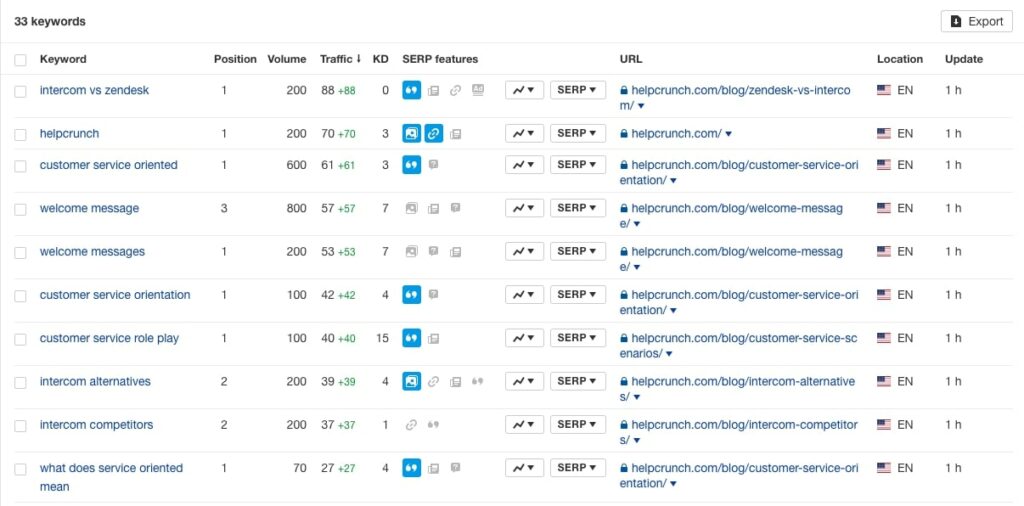
The two most important metrics here that you should definitely keep an eye on are Position and Traffic. They can let you know if your SEO efforts are successful, as in your ranking positions are going up, plus if the increase in rankings is resulting in a traffic boost as well.
Another useful report is the Competitor report. This report gives you a good understanding of where you are in terms of rankings compared to your top competitors.
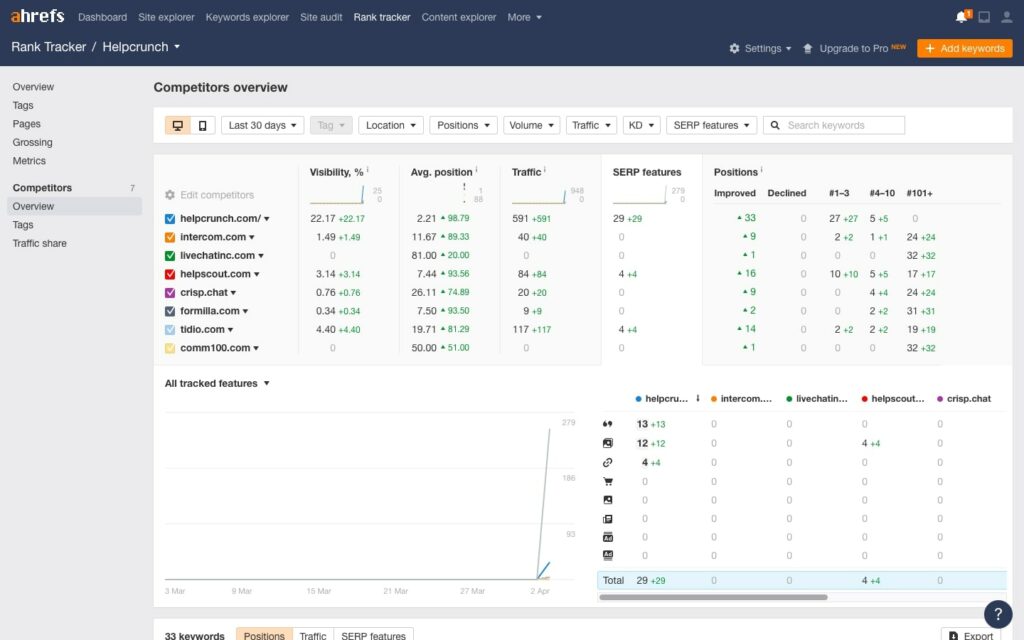
And, no, it doesn’t just give you general information, but shows you how each one of your top competitors is ranking for your tracked keywords—something you don’t find in every tool.
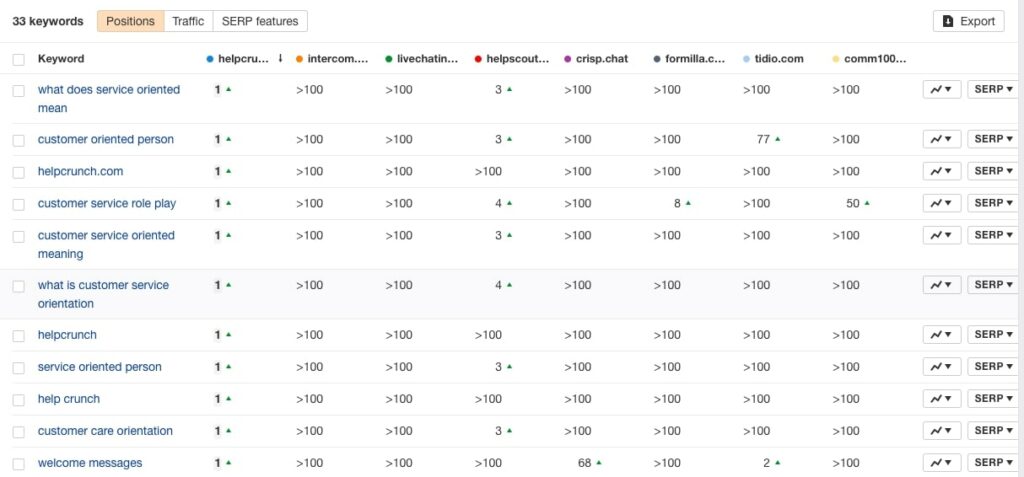
This is great for updating and adjusting your keyword strategy to outrank the rivals. Find out where you’re really behind and what keyword you could focus on more in your campaigns.
Now, if you want to just look at all the available metrics Ahrefs has to offer on your tracked keywords, check out the Metrics report.
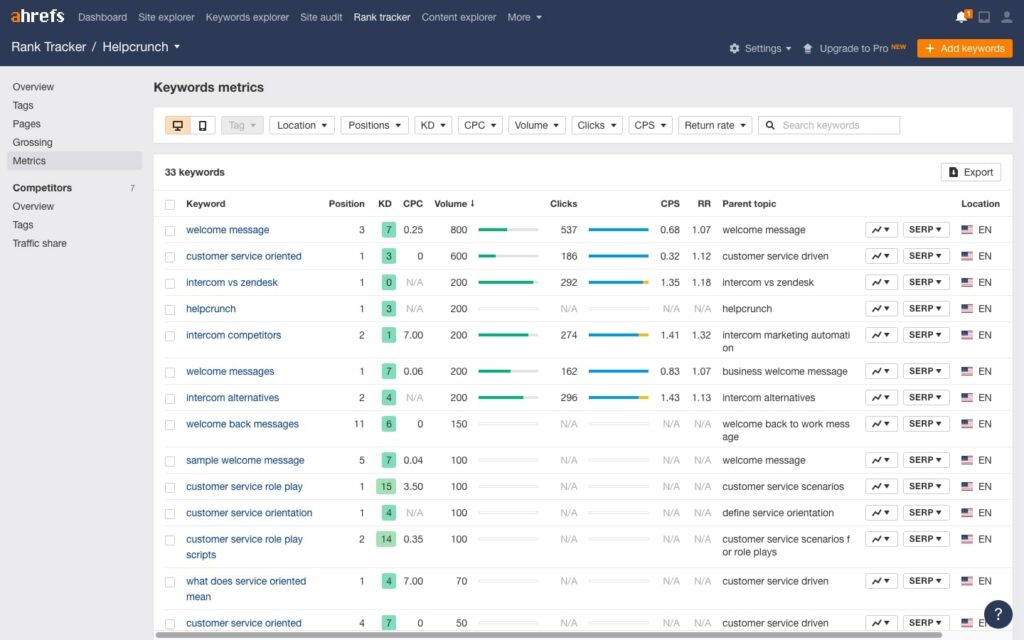
Here you have even more keyword data such as the keyword difficulty score, cost-per-click, search volume, estimated number of clicks it will get in SERPs, click-per-search (shows an estimate of how many results an average users clicks), return rate (shows how often the same user makes the same search within a month), SERP features, and Parent Topic (shows if you can possibly rank for your target keyword, and at the same time, target another keyword that’s similar but has a higher search volume).
And, finally, Ahrefs has the Grossing report that provides you with data on your tracked keywords’ ranking dynamics. You can, basically, see how rankings have changed in the last day, week, month, 90 days, or all time.
To sum up, Ahrefs is pretty effective in tracking keywords and is generally a solid tool. But if you need a tool that is excellent at tracking keywords, we’d recommend you try Semrush and SE Ranking.
Site Audit
If you’re just starting your SEO journey and need to know which way to go, or if you’re managing multiple sites for an agency, Ahrefs’ Site Audit tool can crawl your site in real time with the goal of finding technical errors and suggesting ways of fixing them. With this tool, you can quickly pindown broken links, redirects, 404s, and get details on the page loading speed and social tags. The best part is that you can use filters to single out specific problems and focus on their solution.
So, just add any domain name, be it yours or a competitor’s, and the audit will start. There are, however, several things you can do to customize the audit the way you see fit. They should be revealed in more detail in the review about Ahrefs.
Start by verifying your domain ownership using any provided method. Doing so will help Ahrefs crawl your site faster.
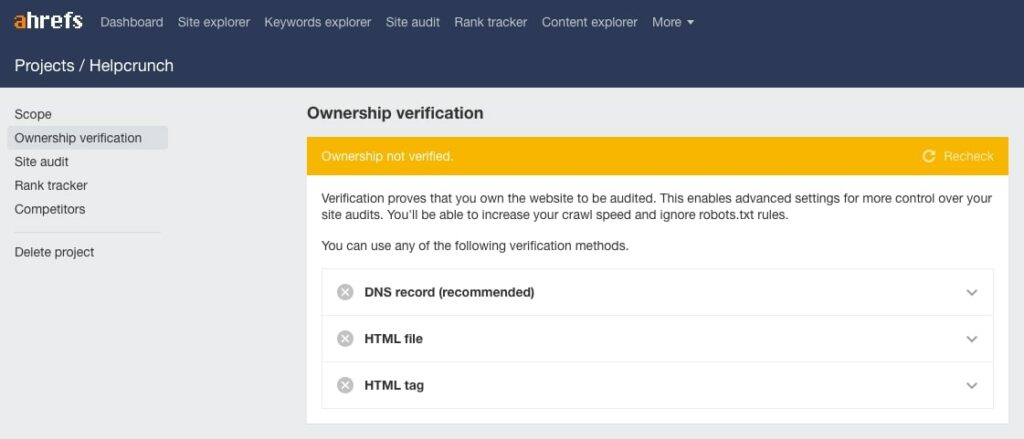
In addition, we want to point out that if you don’t verify your domain, the crawl speed will be limited to a single request per second. If you can’t do anything about verifying competitor domains, the least you can do is verify your own site.
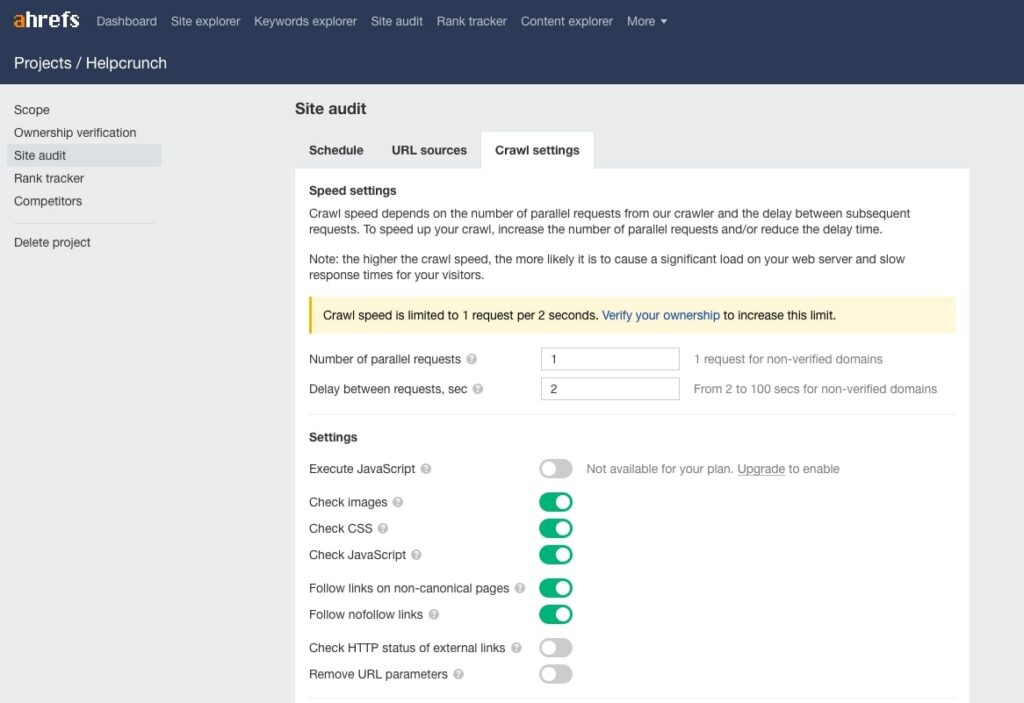
The default Site Audit setup is perfectly fine, however, you can change the settings for best results by enabling Javascript execution, setting the maximum number of internal pages and so on.
Now, depending on the audited site’s size and your setup, it could take a while for the audit to complete, but once it’s done, you will see an overview of the site’s on and off-page SEO health.
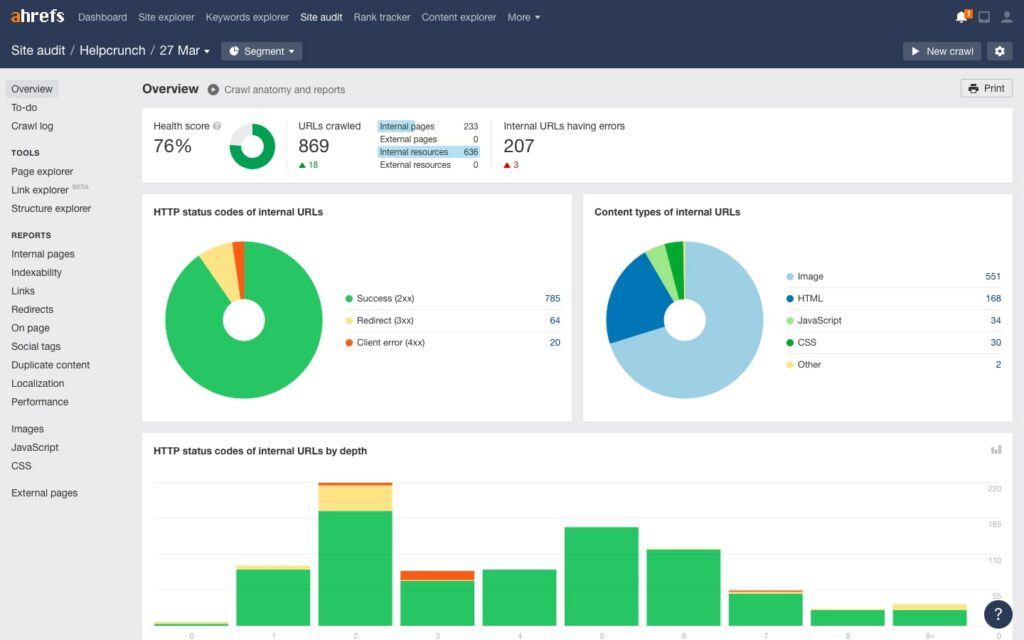
Take a good look at the results and figure out where you are struggling the most. Go for the tech SEO segment you’d like to take care of first, and then continue from there. Occasionally, the performance report may produce somewhat inaccurate data, however, the number of factors involved here could impact the final score.
We can draw an interesting conclusion from the Ahrefs review. If you are a more experienced SEO practitioner, we strongly encourage you to check out the Page, Link, and Structure explorer tools under Site Audit. There you can experiment with different presets to get actionable data and recommendations.
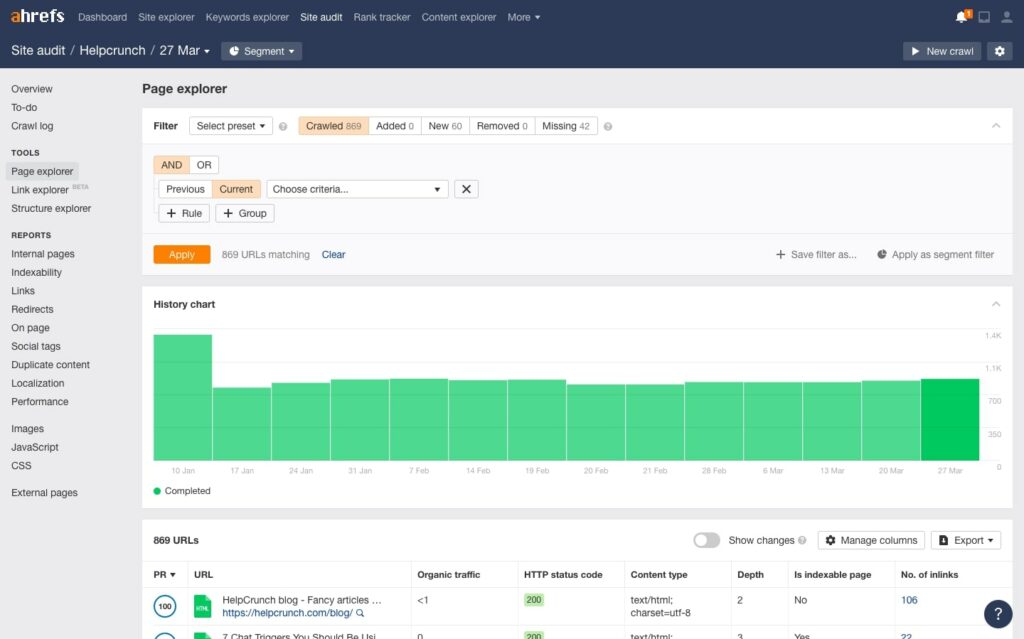
To get the most out of it, take your time to set up the Site Audit tool as soon as you first access Ahrefs. Otherwise, you might not get accurate results, making it more difficult to improve the site’s SEO health.
Moreover, Ahrefs has a neat and useful To-do feature under Site Audit. Just choose an issue you’d like to focus on and mark it as a task. That way, you won’t miss anything and will be able to improve your site, step by step.
The bottom line is that, if used correctly, Ahrefs’ Site Audit can help you out a lot. The interface is rather intuitive, making it easy to use for both new and seasoned users. If technical SEO is what you’re after, Ahrefs is a great tool to have.
Competitor Research
If you decide to choose Ahrefs as your go-to SEO tool, then you’ll be spending a large portion of your time in the Site explorer tool. This is the most comprehensive tool you’ll find in the platform that offers in-depth data on any website’s backlinks–we’ll focus on them in the next section–as well as insights into both organic and paid search campaigns. Let’s take a look at all the features offered by Ahrefs’ Site explorer.
The main dashboard, or the Overview page, gives you a bird’s eye view of any website. Here you’ll see Ahrefs’ version of the domain authority metric, the total number of backlinks and referring domains, traffic value, and plenty of other data.
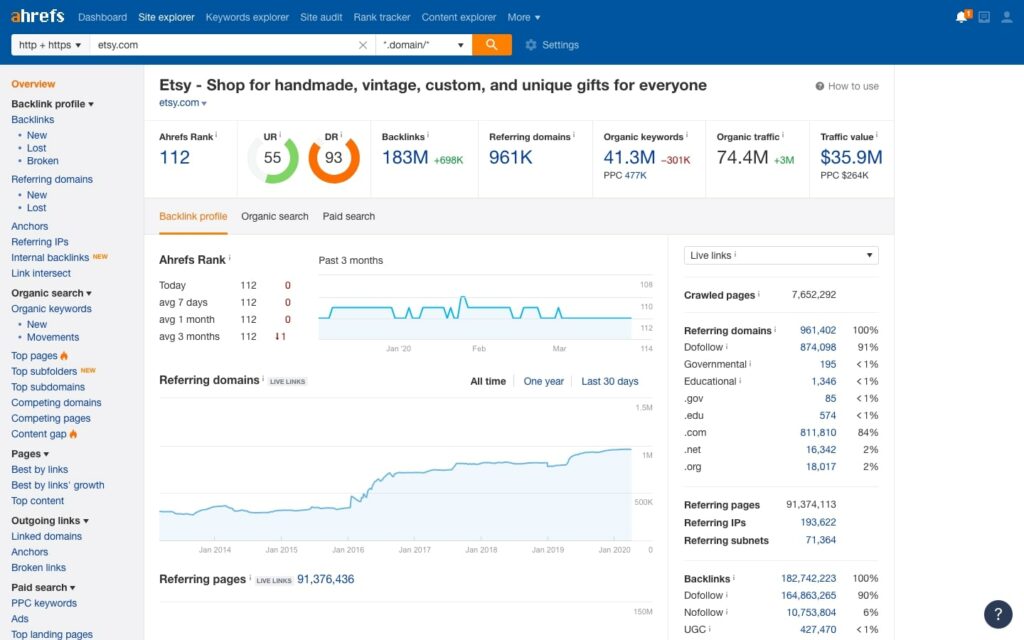
With this overview, you can understand what your rival is doing in no time. As an example, in the Ahrefs review 2024, just take a look to see if a rival’s been getting more backlinks and traffic from organic search lately. If you notice that a competitor’s backlink and traffic numbers aren’t growing that much, this could be a sign that they aren’t doing that good of a job at promoting their site.

As you scroll down the page, you get a plethora of data that includes link growth velocity in linking root domains and unique pages, URL and Domain rating, estimated organic traffic and its growth, most popular content with regard to shares and links, most popular ads running on Google, anchor text cloud, and much more.
As a rule of thumb, you only look at this page to get a general sense of what your competitors are doing in SEO. So, if you need to get a good idea of what’s going on quickly–Ahrefs is your solution. For more specific data, you’ll have to explore other sections.
Next, we have the Top pages area of the tool. Here, you can see which pages drive most traffic from organic search. You’re welcome to analyze all the keywords each page ranks for among Google’s top 100 organic search results, total number of linking root domains, along with the top search query, and its search engine ranking position.
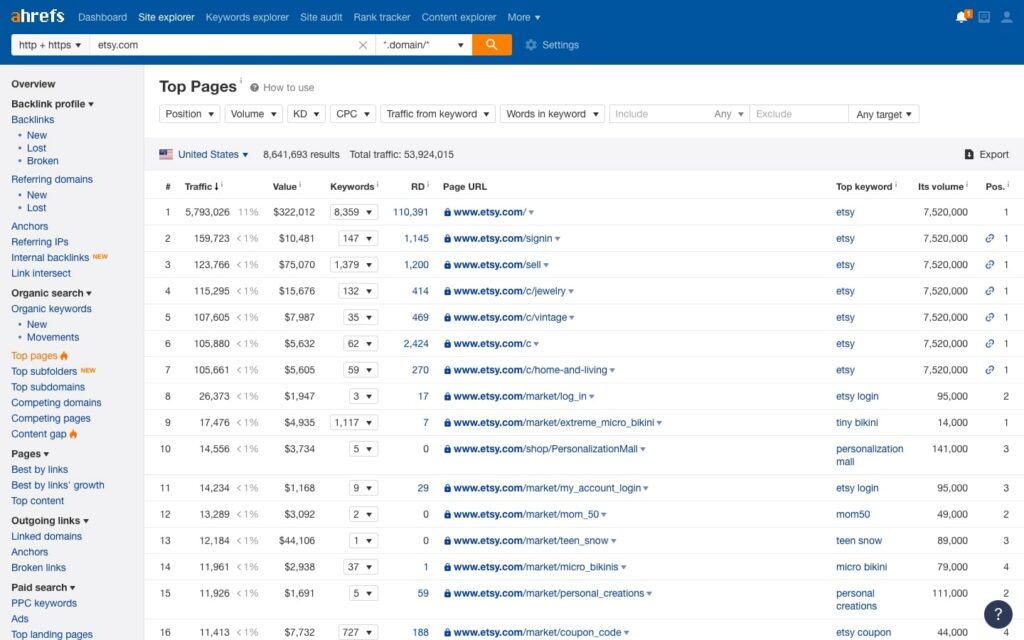
Ahrefs reviews often emphasize the Top Pages feature, which allows you to know what pieces of content are great at driving traffic. That way, you can learn if a certain type of content that you’re not using works like magic for your competitors. This will ultimately allow you to create that type of content.
To get data on organic and paid traffic, explore the Organic search and Paid search subtabs of the tool, respectively. Besides organic data, get a list of keywords your competitors are running ads for, along with their most popular pages and a preview of the ads themselves.
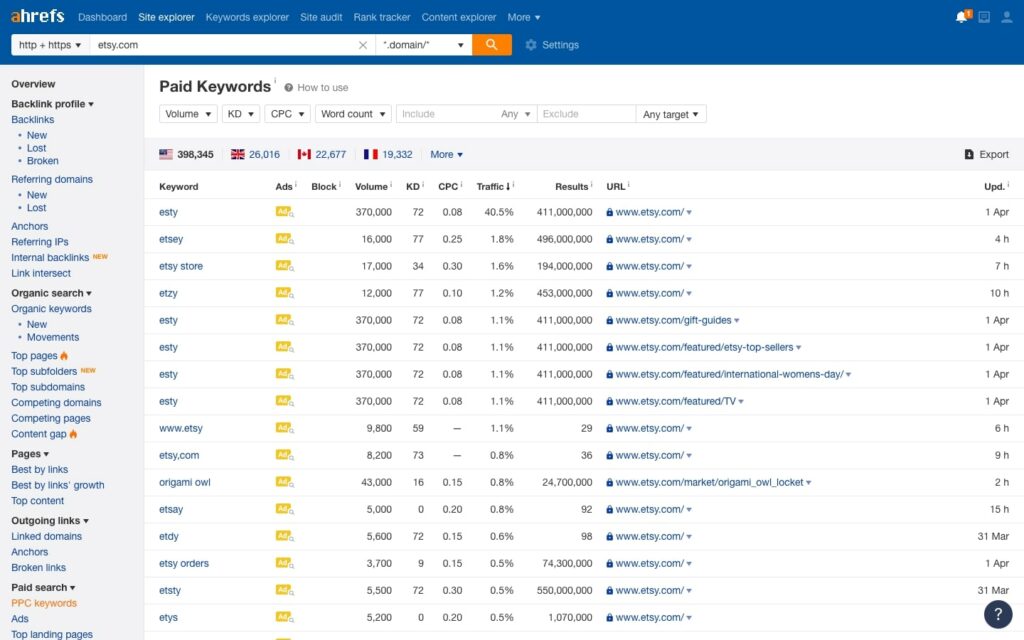
With this data, you can reverse engineer your competitors’ ad campaigns and save a fortune on optimizing yours. This is definitely a huge plus.
The last area of the Site Explorer tool that we want to draw your attention to is the Content Gap. Ahrefs does a great job of showing plenty of data on competing pages and domains, but it also shows you which keywords you’re not ranking for but your competitors are.
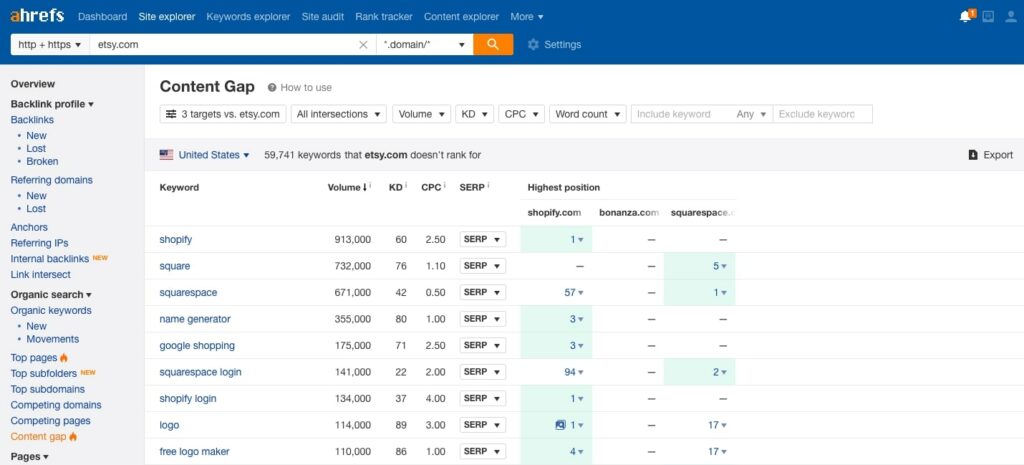
All you have to do is enter several competitors at the top of the page and then run the tool against your domain. We tested this feature in the Ahrefs review and came up with some interesting conclusions. The resulting list shows everything our competitors are doing in terms of keyword campaigns, and we’re not.
Overall, Ahrefs is a solid tool for analyzing your competitors and finding out everything about their organic and paid campaigns. Once you figure out where everything is and how to work the tool, you’ll start forgetting about the cluttered interface and will be able to visually filter out unnecessary data.
Backlink Research
We set out on a mission to find out if Ahrefs really is the most powerful tool on the market in terms of backlink research. They even made this tool free despite the fact that a ‘free’ trial of Ahrefs costs $7 for a week, which proves how confident they are in their backlink analysis capabilities.
In Ahrefs reviews, you can see that the backlink checker is available in the Site Explorer section. Given that you’ve already entered a domain into search, the Backlinks profile area will provide you with a snapshot of the website that includes the domain rating, top 100 backlinks along with top pages and anchor texts
The Backlink profile area is what Ahrefs is most famous for. This actually played a trick on them because many people fail to use Ahrefs for anything else other than checking backlinks.
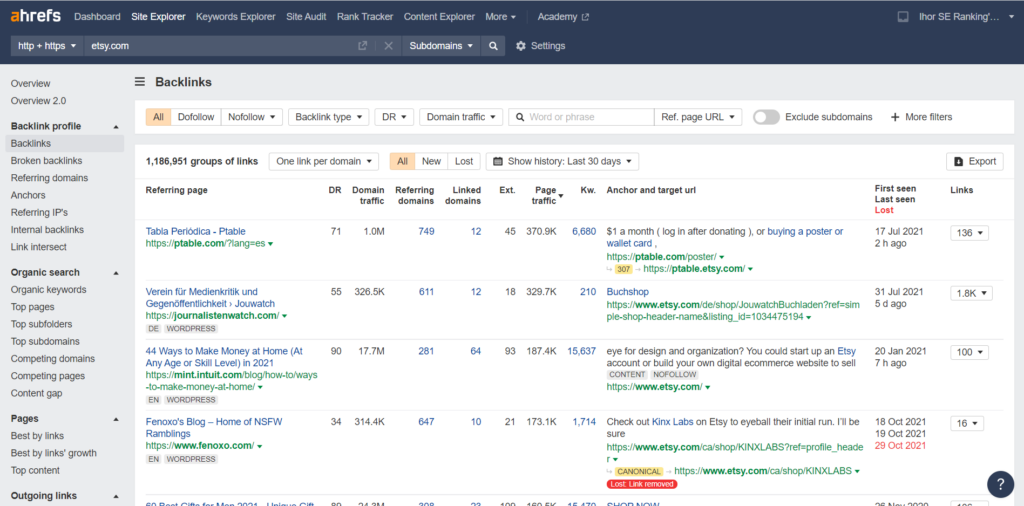
With this tool, you can get vast amounts of data on what links were acquired by competing websites. In turn, this gives you the opportunity to find new ideas for building backlinks to your own site. On top of that, Ahrefs has the disavow tool, just like SE Ranking, that helps you get rid of bad backlinks.
The search giant recommends we clean up any and all ‘bad links’ pointing to your site because it can negatively affect search results. With Ahrefs, you can easily create a disavow file containing bad links, and upload it to Google Search Console. Plus, Ahrefs will log all the disavowed links and domains, so that they don’t show up in the link graph results. This will be a more accurate representation of how Google sees your site.
In the Backlinks section, you can make use of different filters to look at any website’s backlink profile whichever way is most convenient for you. You can decide only to see nofollow or dofollow links, single out redirects, view links with or without a redirect chain, .EDU or .GOV links, links by traffic, and so on. This feature deserves a special mention in the Ahrefs review 2024, as managing link masses is becoming increasingly complicated.
Generally, it’s most useful for quickly finding valuable backlinks that make a big difference. Moreover, under this section, you can get a list of all new and lost backlinks. By the way, here you can also make use of all of Ahrefs’ backlink filters to find links with specific characteristics.
In addition, Ahrefs goes out of its way to give you everything there is to give regarding backlinks. In line with this, it shows you every broken inbound and outbound link on your website.
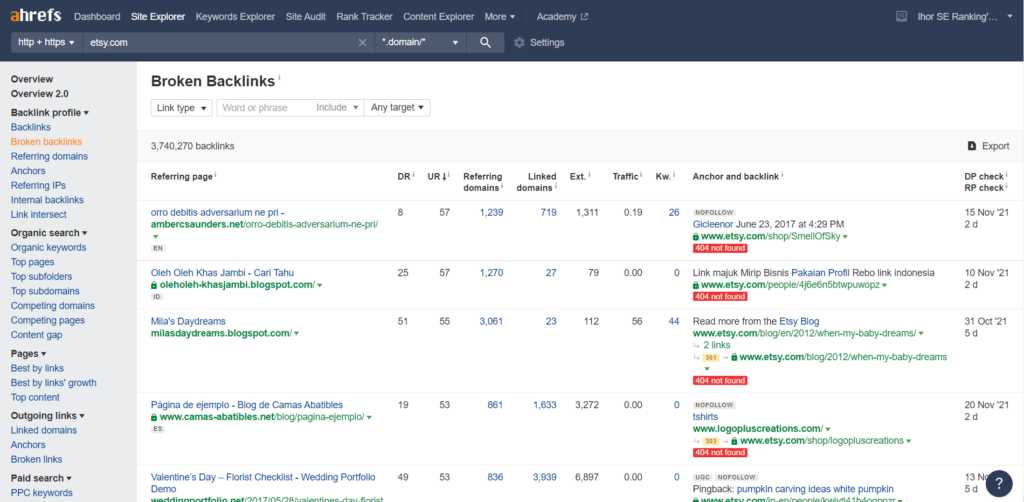
Summing up, Ahrefs is a great tool both for search engine optimization and content marketing. But it may be too expensive if you don’t have a big budget. So, if you’re just starting out with SEO, perhaps you should look at other tools until you know your way around SEO. It can replace a lot of different tools, so it’s definitely worth checking out, especially if you regularly are engaged in building links. But if you run an agency that does both PPC and SEO for customers, you have to explore SE Ranking and Semrush.
Conclusions
The Ahrefs review shows that it was named after the HTML link tag for a reason. Its strong point is the possibility of building a link network, as well as analyzing and managing it in one application. The service provides you with many filters that can be used to sort resources, choosing authoritative, most effective, or suspicious ones.
Any Ahrefs reviews also praise the functionality of other modules, including technical audit, rank tracking, and competitor monitoring. In terms of the amount of information, the level of granularity, and the quality of analytics, the service is definitely among the leaders in its segment.
However, the Ahrefs review also reveals the disadvantages of such a comprehensive approach. The service is aimed specifically at SEO professionals of the Middle level and above. Its interface is very complicated, and the reports contain an incredible amount of raw information, so it is difficult for beginners to draw the right conclusions and find the best ways to optimize websites. Another disadvantage is the paid trial subscription. Yes, you have to pay for testing the platform’s functions.
Frequently Asked Questions
What is Ahrefs?
Ahrefs is a marketing service aimed at professionals in the fields of SEO, content management, and website development and maintenance. It allows you to get a huge amount of information to monitor competitors, determine the current position of your business, and evaluate the effectiveness of your optimization strategy. The platform also offers one of the most powerful technical audit modules, which allows you to quickly solve problems of website availability and performance.
How to use Ahrefs?
Ahrefs is a cloud service that runs in a browser. First of all, it is adapted for desktop computers and laptops — its interface is not very convenient for mobile devices. Unfortunately, the platform is available only through a paid subscription, even in the trial version. To get access to all its features, you will have to confirm the ownership of your website domain.
What is Ahrefs used for?
The most powerful modules of Ahrefs are technical website audit and external link building. With the help of the service, you can identify the most effective resources of your marketing network and block low-quality links. The platform also offers you tools for working with keywords and monitoring competitors, although it is slightly inferior to the leaders in its segment in terms of these features.
How much is Ahrefs?
The basic Lite plan costs $129, and the optimal Standard plan costs $249 per month. For medium-sized companies, the Advanced subscription costs $449, and for large SEO agencies, the Enterprise subscription costs $14,990. It is worth noting that Ahrefs tariff plans are not flexible — you cannot pay extra for individual modules or increase the limit.

Ahrefs in 2024 is all about credits. You run a site explorer? That’s a credit. Pop into a menu? Another credit. Use a filter? Yep, credit. Want to see who’s ranking for what? That’s a credit for each click. You could easily use up 10-20 credits just poking around on one keyword.
I’m not knocking their prices, really. They’re pretty fair for what you get. But this credit system? I just can’t get on board with it. SE Ranking and Semrush feel a lot simpler to deal with.
Hey buddy, this is one of the best Ahrefs reviews I’ve ever seen. But you’re not being fair here. Pricing isn’t the main concern, let’s talk about data quality. What other platforms can compete in this area? SE Ranking, Semrush…Hmmm? That’s the crux of the matter.
That’s pretty funny. The guy who claims to know everything about Ahrefs leaves a comment after reading Ahrefs review. What did you expect to find here that’s new? Or were you just here to leave some rude remarks? Is that really the way to go?
Thanks for sharing this. I’ve seen the cons and want to weigh in:
Single-user subscription plan (5 additional users cost $1K): Okay, that’s fair.
Lacks SEO reporting features: You can always integrate with other reporting tools.
Basic UX functionality: That really depends on the user.
No mobile app: Personally, I don’t think a mobile app is crucial for an SEO tool. Maybe it matters to ppl, but I’ve never seen a good one anyway.
I love Ahrefs. I actually think it should cost more than $999. People complain about the high cost, but hey! Think about how much money this software helps you make!
It’s strange) because the quality of their services does not match the price. in a bad way. And this is what all Ahrefs reviews say.
It’s not true
Whhhaaaaattt? Are you sure you know something about SEO? This is one of the best platforms on the market. Especially after the latest Semrush scandal.
What other ones do you recommend?
I’ve been a big fan of Ahrefs for many years, but lately, I’ve been baffled by their pricing policy. Their new pricing model is just bad; the excuse that “scrapers were abusing their system” is even worse.
Let me be clear — I’m not stingy. I just analyze the market well and know the prices of other popular SEO tools.
If this continues (and I’m sure it will), I’ll switch to another tool and won’t regret it. How a company treats its customers is a crucial criterion when choosing any product.
+1. The recent price changes at Ahrefs have made it nearly three times more expensive for my company to access the same features we’ve always used, which has been a major issue for us. The price increase was neither gradual nor manageable.
where can you find a tool of the same quality at a low price? mission impossible
After reading the article and the comments, I see many are upset about the high prices, and I get why… But when I started out, Ahrefs really helped me avoid messing up with clients, so I’ll always speak highly of them. Guys, try using it for at least a week 🙂 You’ll find that the pros outweigh the cons.
I’ve read a lot of Ahrefs reviews and users are complaining about the same problems en masse. This gives me pause for thought.
Thanks for the article. It’s really thorough. I’d love to see more comparisons of top SEO platforms, especially from a user experience angle. Maybe include some case studies and explain how things work on different platforms.
Just $7 for a 7-day trial! It’s the perfect way to introduce folks to what Ahrefs is all about
Exactly! But at the same time, it’s understandable. Many people post “Unlimited Ahrefs/Semrush accounts” ads in Facebook communities. How do SEO platforms deal with this?
Why not make the trial period free?
The best SEO platform for all my needs
Can you tell us more about your needs?
Did you get paid for ads?
I’ve been using Ahrefs for almost my entire career in marketing. At my current company, we’ve been loyal customers for five years, operating under a legacy plan. Last summer, they announced plans to transition everyone to a pricier and more restrictive plan.
The main feature of Ahrefs is its ability to analyze website traffic, keywords, and links by searching specific URLs. I heavily rely on this feature and use it multiple times a day to gather insights.
However, after being forced to switch from our legacy account (despite being assured otherwise), I discovered that the new plan came with a usage limit. Within a few weeks, I hit my monthly limit of 600 events.
For a tool as expensive as Ahrefs, it’s surprising to encounter such basic usage restrictions. Paying over $2,000 a year, I feel severely limited in utilizing the tool to its full potential. How can I derive value and explore new features if I can’t even meet my daily requirements?
Attempts to discuss these issues with a Customer Success Manager have been fruitless. I’m unable to escalate beyond the basic customer support level, receiving nothing more than insincere apologies from tier-1 live chat agents.
I saw a ton of reviews about Ahrefs, and each one describes a different experience. People use this platform for various tasks (all related to SEO, but the approaches vary). So, rely on your own experience and expertise. This is the best approach in any matter.
Yeah. Faced with this pricing model, we’ve made the decision to terminate our partnership with Ahrefs and transition to a different platform. Thanks
My experience using Ahrefs for SEO has been really good because it provides a wide range of metrics. That’s all
do you use all the metrics? i read a lot of ahrefs reviews and people say that some metrics are meaningless
One of the best reviews about ahrefs, thank you! I especially liked the fact that I can compare the price with other tools. I didn’t realize SE Ranking is more affordable…
Writing a review for Ahrefs is challenging because every agency or individual webmaster uses it differently. However, from my perspective, this platform meets all my needs. It’s reliable, provides precise data, and has an easy-to-understand interface. I believe it exceeds what anyone could expect from an SEO tool. This is my Ahrefs review :))
All reviews about ahrefs should be overridden by one fact – the price. No matter how much you pay for your tariff, there will always be more in the bill. They limit the use of everything. And when you ask them to refund the money they’ve written off, they’ll only give you half of it. I don’t recommend using them to anyone. They are scammers!
haha, finally I saw this comment
I saw an Ahrefs review 2024 update and they’ve added some new features. The keyword explorer is now even more robust with better filtering options.
The main feature they need to get rid of is their pricing system
Does anyone have any long-term Ahrefs user feedback? I’m considering it over other SEO tools but would love to hear from more seasoned users.
Sure, I’ve been using Ahrefs for several years now and can definitely share some Ahrefs user feedback. It’s a core tool in my SEO toolkit due to its robust features like detailed backlink analysis, keyword tracking, and competitor research. The reviews about Ahrefs often highlight how the data it provides is incredibly detailed and quite reliable for planning SEO strategies.
The user interface is pretty intuitive, which makes it easier to navigate through various features. They also update their database frequently, so you get the latest information, which is crucial in the fast-evolving SEO landscape.
However, it’s on the pricier side compared to some other tools, but I find the investment worth it for the depth of data you get. If you’re handling SEO at a scale or for multiple clients, it’s a powerful resource. Just make sure it aligns with your specific needs and budget.
I’ve been toggling through different tools, but Ahrefs keeps coming up as a leader in every review about Ahrefs I find!
I’ve used this tool and heard a lot of Ahrefs reviews before, where people said they loved it, but… I don’t know what the problem is, but the guys are losing their position in the market, giving their places to more advanced tools. I wish Ahrefs success and for the team to start working.
It took me a few months to feel really comfortable using it. I started with the basics, focused on keyword research, and gradually learned more complex functions. But it’s still hard to understand all the features at once.
Did you use any training materials? I read a lot of reviews about ahrefs, but I didn’t find anything like that.
Ahrefs provides a lot of resources. They have an extensive blog, lots of video tutorials on YouTube. If you’re looking for something more structured, their Ahrefs Academy offers free courses that cover everything from basic SEO to advanced content marketing strategies.
It seems you didn’t read well, they have a lot of materials + support
What’s one feature you wish Ahrefs would improve based on the 2024 review?
Definitely the user interface. It’s robust, but there’s a lot of room for making it more intuitive
They should make their platform more accessible and mobile-friendly
I read a lot of ahrefs reviews and people really pointed out this problem
I look at the ahrefs user feedback in the comments and realize that I did the right thing when I changed ahrefs to another tool. Nothing has changed with ahrefs over time.
What tool do you use?
SE Ranking and Moz
My ahrefs review will be short: great tool. accurate data, good price (more for agencies than for freelancers) and regular updates. I don’t understand people in the comments and their negativity. I’m curious what you use yourself that you think ahrefs is something bad.
$15,000 annually… For real? I think any Ahrefs review needs to start with pricing to clearly understand what’s going on here. You need to know what kind of functionality you get, but the price is crucial in this case.
Great article, thanks! But I noticed the meta title is ‘Ahrefs Review 2024: Is It Really Worth $449/mo?’
I’m confused—do you think it’s worth it or not?
If you can afford to pay for it, it’s worth it. But now there are decent alternatives
no
Review about Ahrefs can sometimes be filled with criticism and discussions about pricing, but this one is really thorough. I appreciate how the author clearly outlines both the strengths and weaknesses of the tool. I’ve discovered a lot of new features that I hadn’t noticed before, and I want to mention that I’ve been using Ahrefs for three years already.
Best reviews about ahrefs I’ve seen. I don’t know how long you spent on it, but it’s definitely worth it. I’ve been using Ahrefs for 7 years, so I’d like to share my own pros and cons. Maybe you can use them for future updates or other SEO tool reviews.
Pros:
Awesome Backlink Data: Great for digging into link profiles and competitor backlinks.
Solid Keyword Research: Helps find the best keywords with useful data.
Site Audits: Spots SEO issues and suggests fixes.
Competitive Insights: See what your competitors are up to and find gaps.
Easy to Use: Friendly interface and design.
Content Ideas: Find popular content and see what works.
Regular Updates: Keeps data and features fresh.
Cons:
Pricey: Can be expensive for smaller budgets.
Learning Curve: Lots of features can be overwhelming at first.
Limited Free Version: You need to pay for most features.
Data Accuracy: Occasionally, data might not be spot-on.
Backlink Focused: Heavy on backlinks; less on other SEO aspects.
Tech Issues: Some users report glitches or slow performance now and then.
great time savings! you had to write a review about ahrefs yourself
Their prices are pretty fair for what you get, and the credit system actually makes sense once you get used to it. It’s a different approach, but I find it keeps things efficient. Semrush are great, but Ahrefs just works better for me with this setup.
It seems to me that they already have a different price, you need to update the data
To all newcomers to SEO, be warned: ahrefs is not the platform for you. You’ll just get confused and that’s it. Although it’s unlikely that you’ll even buy it, because the price is becoming more and more incomprehensible.